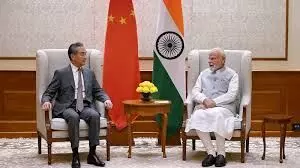After Wang Yi’s Visit: Where Do India-China Relations Stand?
Chinese Foreign Minister Wang Yi’s visit to India signals a cautious reset in bilateral ties after years of tension. From border talks to trade, here’s where India-China relations stand today.
Chinese Foreign Minister Wang Yi meets Prime Minister Narendra Modi in New Delhi, marking a renewed phase in India-China ties.

This week's visit by Chinese Foreign Minister Wang Yi to New Delhi was the first high-level interaction between China and India since the two countries decided to disengage along the border last year. According to a Chinese Foreign Ministry readout, Wang admitted that bilateral relations had experienced "ups and downs" during his meeting with Prime Minister Narendra Modi, emphasising that the lessons learnt should not be forgotten.
A Retrospection: From Hope to Silence
At their informal summit in Mahabalipuram in October 2019, PM Modi and President Xi Jinping expressed optimism regarding their relationship. However, relations reached a breaking point in June 2020, just eight months later, after the clash in the Galwan Valley. Deep mistrust and significant troop deployments on both sides of the Line of Actual Control (LAC) resulted from the deadly encounter, which claimed the lives of 20 Indian soldiers and at least four Chinese personnel.
Both armies remained in tense positions across multiple flashpoints despite numerous rounds of military and diplomatic negotiations. Disengagement had started in key regions like Depsang and Demchok by the end of 2024, and Xi and Modi had decided to "reset ties" in Kazan.
A New Stage of Involvement
Since then, India has dispatched high-ranking ministers and officials to Beijing, including NSA Ajit Doval and External Affairs Minister S. Jaishankar. Wang's first appearance since 2018 is in New Delhi a few weeks before PM Modi's planned trip to Tianjin for the Shanghai Cooperation Organisation (SCO) Summit.
In contrast to Wang's visit in 2022, he was able to meet with PM Modi directly this time, indicating a more cordial diplomatic approach.
Dual-Track Approach: Bilateral Relations and Border Discussions
In order to manage border issues and enhance relations more broadly, both countries have resurrected a dual-track strategy. Important agreements consist of:
- To investigate boundary delineation and improve border management, new expert and working groups have been formed under the WMCC (Working Mechanism for Consultation and Coordination on Border Affairs).
- creation of general-level mechanisms in the middle and eastern sectors in addition to the Western sector's current mechanism.
- reopening the Lipulekh, Shipki La, and Nathu La border trade routes.
- Direct flights will resume, and visa requirements for travellers, companies, and the media will be loosened.
- Increased collaboration in trade and investment, as well as the exchange of trans-border river data in times of crisis.
Important Obstacles to Face
Despite advancements, India still faces a number of issues:
- At least 50,000 Chinese soldiers are still stationed in eastern Ladakh.
- The close military ties between Beijing and Pakistan were emphasised during "Operation Sindoor."
- China's proposed mega-dam on the Yarlung Tsangpo (Brahmaputra) has been opposed by India.
- Restrictions on Chinese exports of rare earths, tunnel boring machines, and fertilizers, impacting India’s economy.
- One of India's main security concerns is the need for more robust action against cross-border terrorism.
The Road Ahead
While Wang Yi’s visit has signaled a thaw, the trust deficit remains the biggest obstacle. India insists that peace on the border is essential for normalizing ties. The coming months, particularly PM Modi’s Tianjin visit, will be crucial in determining whether this reset in India-China relations can be sustained.

